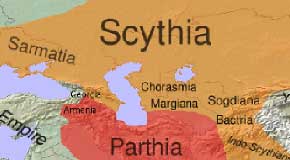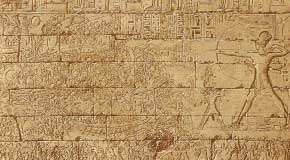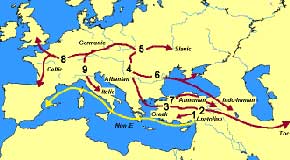Proto-Indo-European root
The roots of the reconstructed Proto-Indo-European language (PIE) are basic parts of words that carry a lexical meaning, so-called morphemes. PIE roots usually have verbal meaning like "eat" or "run". Roots never occur alone in the language. Complete inflected words like verbs, nouns or adjectives are formed by adding further morphemes to a root. Typically, a root plus a suffix forms a stem, and adding an ending forms a word.Suffix and ending together are sometimes called the desinence (German: Ausgang), especially when they are fused.
For example, *bʰéreti 'he carries' can be split into the root *bʰer- 'to carry', the suffix *-e- 'imperfective aspect' and the ending *-ti 'present tense, third person singular'.
In its base form, a PIE root consists of a single vowel, preceded and followed by consonants. Except for a very few cases, the root is fully characterized by its consonants, while the vowel may alternate, a process called ablaut. Thus, the mentioned root *bʰer- can also appear as *bʰor-, with a long vowel as *bʰēr- or *bʰōr-, or even unsyllabic as *bʰr-, in different grammatical contexts.
Phonotactics
Phonotactics describes the restrictions on the permissible combinations of phonemes (sounds).
Basic root structure
The centre of a PIE root is the ablauting vowel (usually *e, perhaps sometimes *a in its base form, the full grade). This vowel constitutes a sonority peak that is preceded and followed by a sequence of consonants with progressively decreasing sonority values. In other words, the sonority has to fall toward both edges of the root. The sonority hierarchy is as follows:
- non-labial sonorants *l *r *y *n
- labial sonorants *w *m
- plosives (sounds like *p *t *ḱ *k *kʷ or *bʰ; see Proto-Indo-European phonology for a complete table of PIE plosives)
This gives the following root structure (with P being any plosive and an empty position):
*w after a vowel is often written *u, and *y after a vowel is often written *i. Thus, *leiǵ- = *leyǵ- 'to bind' and *dʰeu- = *dʰew- 'to run' are allowed roots.
Other possible roots include *ped- 'to tread', *dʰwes- 'to breathe' and *wleikʷ- 'to moisten'. Forbidden are structures like **mter- (wrong order of phonemes: internal plosive) and **wmek- (two phonemes of the same group: unchanging sonority).
Additional phonemes
The remaining sounds, namely the laryngeals *h₁ *h₂ *h₃ and the sibilant *s, can occupy almost any place in the hierarchy. *s is particularly common in initial position (see s-mobile).Examples of such roots are *peth₂- 'to fly', *treh₁w- 'to nourish' and *streig- 'to stroke'.
Following the terminology of Sanskrit grammar, roots ending in laryngeals are referred to as seṭ-, all others as aniṭ-roots.
Restrictions on the plosives
A root cannot contain two plain voiced plosives (**ged-), nor can it contain a voiced aspirate and a voiceless plosive (**tebʰ-), unless the latter occurs in a word-initial cluster after an *s (e.g. *stebʰ- 'to stiffen').
Restrictions on the number of phonemes
The vowel has to be preceded and followed by at least one consonant each. The maximum number of consonants seems to be five (as in *strengʰ- 'to twine').
Early PIE scholars reconstructed a number of roots beginning or ending with a vowel. The latter type always had a long vowel (*dʰē- 'to put', *bʰwā- 'to grow', *dō- 'to give'), while this restriction did not hold for vowel-initial roots (*ed- 'to eat', *aǵ- 'to drive', *od- 'to smell'). Laryngeal theory can explain this behaviour by reconstructing a laryngeal following the vowel (*dʰeh₁-, *bʰweh₂-, *deh₃-, resulting in a long vowel) or preceding it (*h₁ed-, *h₂eǵ-, *h₃ed-, resulting in a short vowel). These reconstructions obey the mentioned rules.
Roots without a full grade
Some roots have no central *e, an example being *bʰuH- 'to grow, to become'. Such roots can be seen as generalized zero grades of forms like **bʰweH-, and thus follow the phonotactical rules.
Exceptions
Some roots like *pster- 'to sneeze' or *pteh₂k- 'to duck' do not appear to follow these rules. This might be due to incomplete understanding of PIE phonotactics or to wrong reconstructions. *pster-, for example, might not have existed in PIE at all, if the Indo-European words usually traced back to it are onomatopoeias.
Thorn clusters are sequences of a dental (*t *d *dʰ) plus a velar plosive (*k *g *gʰ etc.). Their role in PIE phonotactics is unknown. Roots like *dʰgʷʰei- 'to perish' apparently violate the phonotactical rules, but are quite common.
Lexical meaning
The meaning of a reconstructed root is conventionally that of a verb; the terms root and verbal root are almost synonymous in PIE grammar. This is because, apart from a limited number of so-called root nouns, PIE roots overwhelmingly participate in verbal inflection through well-established morphological and phonological mechanisms. Their meanings are not always directly reconstructible, due to semantic shifts that led to discrepancies in the meanings of reflexes in the attested daughter languages. Many nouns and adjectives are derived from verbal roots via suffixes and ablaut.
Nevertheless, some roots did exist that did not have a primary verbal derivation. Apart from the aforementioned root nouns, the most important of these were the so-called Caland roots, which had adjectival meaning. Such roots generally formed proterokinetic adjectives with the suffix *-u-, thematic adjectives in *-ró- and compounding stems in *-i-. They included at least *h₁rewdʰ- 'red', *h₂erǵ- 'white', *dʰewb- 'deep' and *gʷreh₂- 'heavy'.
Word formation
Fully inflected words are usually formed from a root plus a suffix plus an ending. The suffix is sometimes missing, which has been interpreted as a zero suffix. Words with zero suffix are termed root verbs and root nouns. Beyond this basic structure, there is the nasal infix, a present tense marker, and reduplication, a sort of prefix with a number of grammatical and derivational functions.
Finite verbs
Main article: Proto-Indo-European verbs
Verbal suffixes, including the zero suffix, convey grammatical information about tense and aspect, two grammatical categories that are not clearly distinguished. Present and aorist are universally recognised, while some of the other aspects remain controversial. Two of the four moods, the subjunctive and the optative, are also formed with suffixes, which sometimes results in forms with two consecutive suffixes: *bʰér-e-e-ti > *bʰérēti 'he would carry', with the first *e being the present tense marker, and the second the subjunctive marker. Reduplication can mark the present and the perfect.
Verbal endings convey information about grammatical person, number and voice. The imperative mood has its own set of endings.
Nouns and adjectives
Main article: Proto-Indo-European nominals
Nouns usually derive from roots or verb stems by suffixation or by other means (see the morphology of the Proto-Indo-European noun for some examples). This can hold even for roots that are often translated as nouns: *ped-, for example, can mean 'to tread' or 'foot', depending on the ablaut grade and ending. Some nouns like *agʷn-o- 'lamb' or *h₂ster- 'star', however, do not derive from verbal roots. In any case, the meaning of a noun is given by its stem, whether this is composed of a root plus a suffix or not. This leaves the ending, which conveys case and number.
Adjectives are also derived by suffixation of (usually verbal) roots. An example is *ǵn̥h₁-tó-s 'begotten, produced' from the root *ǵenh₁- 'to beget, to produce'. The endings are the same as with nouns.
Infinitives and participles
Infinitives are verbal nouns and, just like other nouns, are formed with suffixes. It is not clear whether any of the infinitive suffixes reconstructed from the daughter languages (*-dʰye-, *-tu-, *-ti-, among others) was actually used to express an infinitive in PIE.
Participles are verbal adjectives formed with the suffixes *-ent- (active imperfective and aorist participle), *-wos- (perfect participle) and *-mh₁no- or *-m(e)no- (mediopassive participle), among others.[22]
Root extensions
Root extensions are additions of one or two sounds, often plosives, to the end of a root which do not seem to change its meaning. For *(s)teu- 'to push, hit, thrust', we can reconstruct
- *(s)teu-k- > Ancient Greek τύκος (túkos) 'hammer'
- *(s)teu-g- > English stoke (Germanic k goes back to PIE *g.)
- *(s)teu-d- > Vedic tudáti 'beats'
The source of these extensions is not known.




